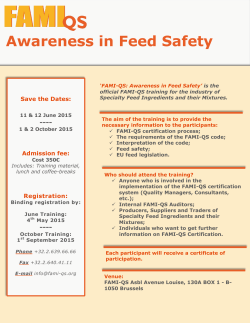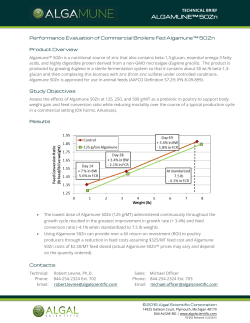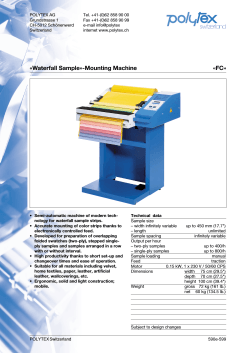
Control - Hamlet Protein
Early nutrition for broiler chickens Prof. Paul A. Iji School of Environmental and Rural Science, University of New England, Armidale NSW, Australia. Email: piji@une.edu.au Outline of my Presentation • • • • Background Gut development in broiler chickens Early nutrition and its benefits Early feeding programmes – In ovo feeding – Immediate post-hatch access to feed • Products used in early feeding programmes • Other nutritional interventions • Conclusion. Background • The starter phase now represents 24-36 % of the production cycle of broiler chickens • Nutrition during this period is not only useful for development of digestive function but for long term productivity • Chicks could be provided with early nutrition in a number of ways • Which are the most sustainable procedures and products? Gut Development in Broiler Chickens Natural development is a difficult concept to define because of: Variation in bird strains Variation in ingredients Environmental differences Analytical procedures. Comprehensive study on the Steggles x Ross (Iji, 1998, 2001) • Several studies have shown that supply organs develop more rapidly in the stater period than the other organs or body: At hatch 5d 10d 24d Body weight Small intestine Pancreas 46.6 1.53 0.11 110.0 5.65 0.50 306.0 8.3 0.46 1384.0 4.9 0.23 Bursa 0.05 0.16 0.16 0.15 UNE Database Morphology of intestinal mucosa at different sites and ages. DUODENUM JEJUNUM ILEUM Hatch Day 21 Scale bar: 1000 mm Iji et al. (2001b) Cell proliferation also occurs outside the crypt 1 hour 96 hours Bromodeoxyuridine was administered at 1 day of age. Similar tests were conducted on days 7, 14 and 21. Iji et al. (2001a) Biochemical indices of mucosal growth At hatch DNA content (mg/g tissue; cell population) Duodenum 3.6a Jejunum 1.7a 21d 0.4b 1.0b Ileum 2.9a Protein:DNA ratio (cell size) 0.9b 9.9b 15.5b 10.7b 78.7a 71.4a 29.4a Duodenum Jejunum Ileum a,b – Comparisons within the same row. Iji et al. (2001a) Early Nutrition and its Benefits Hatchery practices • Chicks hatch over a wide time window • Initial dependence on yolk sac for nutrients • Weight losses occur and intestinal development may be hampered • Would chicks benefit from early access to feed? • How should such feed be delivered? Weight loss of unfed chicks post-hatch Careghi et al. (2005) Effect of feed restriction and glucose supplementation on weight and FCR of broiler chickens 14d 35d Weight (g) FCR Weight (g) FCR Fed at hatch 370a 1.37a 1732 1.67 Fed + Glucose 368a 1.34a 1849 1.66 Water/No Feed 349b 1.33a 1657 1.68 No Water/No Feed 343b 1.25b 1756 1.64 a,b – Significantly different (P<0.001) on the same column. Restriction was for 36h. Ao (2004) Villus height and crypt depth at the jejunum of held vs immediate fed chicks Villus height Crypt depth b b 150 100 50 Crypt depth (mm) Villus height (mm) a 200 a 50 b 40 b 30 20 10 0 0 0 18 36 Duration of fasting (h) 0 18 36 Duration of fasting (h) a,b – Significantly different (P<0.05) Gonzales et al. (2003) Early feeding programmes • Programmes could be egg-based or posthatch o In ovo administration of nutrients o Intubation (gavage) of liquid-based nutrients o Delivery via drinking water o Supplementation with solid feed o Hatching on site (Patio system). Nutrient In ovo feeding Effect of in ovo administration of carbohydrates on body weight Age (days) Control In ovo % Difference Hatch 48.9b 52.6a +7.6 3 69.3b 74.8a +7.9 7 129.0b 134.6a +4.3 10 156.3b 161.7a +3.5 35 1523.0b 1591.0a +4.5 a, b – Significantly different (P<0.05) on the same row. Uni et al. (2004) Response to in ovo administration of amino acids Control Lys+Arg Wt (wk 1, g) 72.6b 74.7b Wt (wk3, g) BWG (0-3 wk) 241.2 197.5 264.0 219.6 Lys+Met+Cys 78.9ab 273.6 228.1 Thr+Gly+Ser 81.6a 271.0 223.8 Ile+Leu+Val 87.8a 304.8 256.6 Gly+Pro 78.8ab 304.4 257.9 a, b – Significantly different (P<0.05) on the same column. Bhanja & Mandal (2005) Activities of pancreatic enzymes in response to in ovo administration of threonine Pepsin 5.25 5.15 Amylase 57.90 58.59 Trypsin 0.23 0.21 10 6.50 67.76 0.26 20 6.81 71.34 0.29 30 6.11 70.20 0.28 40 5.30 61.75 0.30 Control Sham (H2O) Threonine (mg) Kadam et al. (2008) Effect of in ovo administration of carbohydrates on jejunal villus height Control Villus height (m m) 500 In-ovo fed 400 * * * 300 200 100 0 18 19 20 21-Hatch Days of incubation * – Significantly different (P<0.05) for the same age. Uni et al. (2004) Hatchability (%) and hatching weight (g) in response to in ovo administration of betaine a b a, bMean b a a a with unlike superscripts are significantly different (P<0.001). Kadam al. (2013) Progress with in ovo nutrition • Slow adoption – Hatchability issues? • Identification of new products – Range of products tested vis-à-vis response • Alternative post-hatch programmes. Early Post-hatch Access to Nutrients Response to early access to feed on site Effect of delayed feeding or early access to carbohydrate supplementation on broiler chickens Control1 Palatinose2 Trehalose2 Held3 Fed4 Held3 Fed4 Held3 Fed4 SEM 1-21 days Feed intake 819.3b 851.1b 869.8b 853.5b 1012.2a 1053.0a 16.96*** 21d-wt 619.2b 670.1b 665.8b 668.2b 735.7a 784.8a 10.77*** 1.43 1.38 1.40 1.38 1.46 1.44 0.01 FCR 1 Commercial diet; 2 Fed at 1 % of diet; 3 Feed was delayed for 36h; 4 Fed within 8 hours of hatch. Bhuiyan et al. (2007) Effect of delayed feeding or early access to carbohydrate supplementation on nutrient digestibility Control1 Palatinose2 Trehalose2 Held3 Fed4 Held Fed Held Fed SEM Gross energy Protein 0.69 0.69 0.70 0.73 0.69 0.71 0.006 0.81 0.80 0.83 0.83 0.82 0.83 0.004 Starch 0.86 0.87 0.88 0.88 0.90 0.90 0.007 1 Commercial diet; 2 Fed at 1 % of diet; 3 Feed was delayed for 36h; 4 Fed within 8 hours of hatch. Bhuiyan et al. (2007) Patio hatchers: Commercial solution to early access to feed? Growth of broiler chickens hatched in a patio system vs conventional hatchery Van de Ven et al. (2012) Substrates and ingredients used in early feeding programmes Carbohydrate sources Feed intake and body weight of chicks (14d) on different water-based carbohydrate supplements Feed intake Body weight Bhuiyan et al. (2011) Activities of digestive enzymes of chicks (14d) on different feed-based carbohydrate supplements Maltase Sucrase 0.5 g/kg 1.0 g/kg 2.0 g/kg 0.5 g/kg 0.08 m mol/mg prot/min m mol/mg prot/min 1 1.0 g/kg 0.8 0.6 0.4 0.2 0 Control 0.5 g/kg Palatinose 1.0 g/kg Trehalose 2.0 g/kg 2.0 g/kg a 0.06 0.04 b bb ab ab b 0.02 0 Control Palatinose Trehalose a,b – Significantly different (P<0.05). nmol/mg prot/min 15 Chymotrypsin 12 9 6 3 0 Control Palatinose Trehalose Bhuiyan et al. (2011) Protein sources • Animal vs plant proteins • Animal products o o o o o Higher protein content Better amino acid balance Fewer concerns of toxic factors Main concern is zoonotic diseases Cost and supply in some regions • Plant products o Higher CP content than original source o Poorer amino acid balance than animal products o Lower levels of antinutritive factors than source products 35-d Body weight of broiler chicks in response to spray-dried porcine plasma in starter diets Maize-based diets (35d) 2676.0ᵃ Body weight (g) 2700 2608.7ᵃᵇ 2629.4ᵃᵇ 2544.4ᵇ 2600 2500 2400 2300 Control 5 g/kg SDPP 10 g/kg SDPP Wheat-based diets (35d) 20 g/kg SDPP 2735.4ᵃ Body weight (g) 2800 2700 2538.1ᵇ 2578.4ᵃᵇ 2567.9ᵇ 2600 2500 2400 2300 Control 5 g/kg SDPP 10 g/kg SDPP 20 g/kg SDPP Beski et al. (2015) FCR of broiler chicks on diets supplemented with SDPP (1-35d) FCR g/g Maize-based diets 1,8 1,6 1,4 1,2 1,0 1.61ᵃ 1.2ᵃ Control 1.58ᵃᵇ 1.13ᵇ 5 g/kg SDPP 1.52ᵇ 1.1ᵇ 10 g/kg SDPP 1.53ᵇ 1.09ᵇ 20 g/kg SDPP FCR g/g Wheat-based diets 1,8 1,6 1,4 1,2 1,0 1.64ᵃ 1.20ᵃ Control 1.60ᵃ 1.12ᵇ 5 g/kg SDPP 1.56ᵃ 1.07ᶜ 10 g/kg SDPP d 10 d 35 d 10 d 35 1.46ᵇ 1.07ᶜ 20 g/kg SDPP Beski et al. (2015) Jejunal villus height (at 24d) of broiler chicks on diets supplemented with SDPP 2100 2017.4ᵃ 2000 Villus height (µm) 1900 1881.7ᵇ 1929.4ᵃᵇ 1980.5ᵃ 1800 1700 1600 Control 5 g/kg SDPP 10 g/kg SDPP 20 g/kg SDPP 2100 2000 1976.1ᵃ 1915.4ᵃ 1900 1917.1ᵃ 1840.5ᵃ 1800 1700 1600 Control 5 g/kg SDPP 10 g/kg SDPP 20 g/kg SDPP Beski et al. (2015) Other responses to starter levels of SDPP • The digestibility of protein, gross energy and dry matter was largely similar at 24 of age with both grain types. • Dressing % was increased about 2.5%. Performance of broiler chickens in response to different protein fractions from meat and bone meal (1-28d) Feed intake Body wt. gain (g/bird) (g/bird) Control – No handling 1104.4 630.9 FCR (g/g) 1.75 Control – PBS 1135.9 638.1 1.78 Control – handled 1139.8 659.9 1.73 Fraction 1, <3 kDa 1191.1 680.1 1.76 Fraction 2, 3-100 kDa 1150.7 679.5 1.70 Fraction 4, >100 kDa 1067.7 607.4 1.76 Fractions contained different proportions of structural, metabolic, enzyme, milk, blood and immune proteins. Muir et al. (2013) Proprietary Products Oasis® Oasis in-tray application (about 250 g per 100 chicks or 2.5 g per chick) Performance of broiler chickens at market age following maintenance on Oasis Held Feed Oasis solid Water Oasis liquid Noy & Sklan (1999) FI and BW of broilers to starter levels of HP AviStart at 35d Beski et al. (2015) FCR of broilers to starter levels of HPA at 1-10d and 1-35d Beski et al. (2015) Jejunal histomorphology (µm) of broiler chickens (24d) in response to HPA HPA levels (g/kg diet) 0 Villus height 1619.1c 25 1691.5bc 50 1816.8a 100 1759.0ab Crypt depth 144.3a 139.9ab 131.0b 129.7b Villus/crypt 12.0b 11.8b 14.0a 11.3a Villus SA1 0.59 0.68 0.72 0.64 1. Apparent villus surface area (mm2) Beski et al. (2015) Mucosal protein content and enzyme activities of broiler chickens (24d) in response to HPA HPA levels (g/kg diet) Jejunum 0 25 50 100 Protein 18.4 19.1 19.4 18.9 Maltase 2.2 2.4 2.1 2.5 Sucrase 0.18 0.17 0.16 0.17 Alk. Phos. 0.102 0.099 0.094 0.109 50.6 53.2 53.1 47.9 Chymotrypsin 3.2ab 3.0b 3.2ab 4.0a Lipase 0.64 0.63 0.60 0.75 Pancreas Protein Protein (mg/g tissue); Enzymes (mol/mg protein/minute) Beski et al. (2015) Ileal nutrient digestibility of broilers (24d) in response to HPA HPA levels (g/kg diet) 0 25 50 100 Protein 0.74 0.77 0.79 0.78 Gross energy 0.69 0.72 0.74 0.73 DM 0.84 0.85 0.83 0.84 Beski et al. (2015) Carcass characteristics (g) of broilers (35d) in response to HPA HPA levels (g/kg diet) Dressing% 0 75.6 25 75.9 50 76.5 100 77.1 Breast 655.2 638.2 703.7 694.4 Thigh Drumstick 294.6 235.0 299.4 231.4 330.4 248.5 323.1 240.7 Beski et al. (2015) Other Nutritional Interventions Colour of pre-starter diets and performance of broiler chickens Body weight, day 3 Control 74.5 Red 76.5 FCR, 0-3d 0.86 0.90 Final weight, 42d 2019 2059 FCR, 0-42d 1.74 1.74 Enting et al. (2009) Particle size of pre-starter diets and performance of broiler chickens Body weight, day 7 Crumble 145b 2 mm pellet 156a Feed intake, 0-7d (g/day) 17.9 18.1 FCR, 0-7d 1.19a 1.09b Final weight, 42d 2028b 2066a Feed intake, 0-42d 80.9 82.0 FCR, 0-42d 1.74 1.74 Enting et al. (2009) Conclusion • Our knowledge of digestive physiology of modern strains • Scope for adopting existing applications • Development of future applications • Role of suitable products for pre-starter diets. Acknowledgment • • • • RIRDC (Australia) Feedworks (Australia) Hamlet Protein Post-docs and PhD students – – – – Dr Momen Bhuiyan Dr Seng Huan Chee Sleman Beski Apeh Omede Some Poultry Group Members, UNE, 2013
© Copyright 2025









